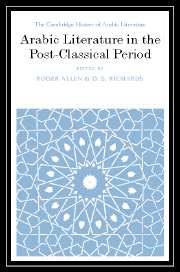Book contents
- Frontmatter
- The post-classical period: parameters and preliminaries
- Part I Elite Poetry
- Part II Elite prose
- 5 Pre-modern belletristic prose
- 6 The essay and debate (al-risāla and al-munāzara)
- 7 The maqāma
- 8 Mamluk history and historians
- 9 Historiography in arabic during the ottoman period
- Part III Popular poetry
- Part IV Popular prose
- Part V Drama
- Part VI Criticism
- Bibliography
- Index
- References
5 - Pre-modern belletristic prose
from Part II - Elite prose
Published online by Cambridge University Press: 28 March 2008
- Frontmatter
- The post-classical period: parameters and preliminaries
- Part I Elite Poetry
- Part II Elite prose
- 5 Pre-modern belletristic prose
- 6 The essay and debate (al-risāla and al-munāzara)
- 7 The maqāma
- 8 Mamluk history and historians
- 9 Historiography in arabic during the ottoman period
- Part III Popular poetry
- Part IV Popular prose
- Part V Drama
- Part VI Criticism
- Bibliography
- Index
- References
Summary
introduction
Any survey of pre-modern belletristic prose in Arabic cannot avoid discussion of generic hierarchies. Such controversies and debates are deeply rooted in processes of political and cultural transformation, trends that demand, and at times instigate, new yardsticks and scales of gradation among literary genres. But even at a time in Arabic literary history when chancery interests assured prose a lofty status, there emerged a tendency, after the appearance of the Maqāmāt of al-Harīrī (445–516/1054-1122), to assess, compare and grade clerks and scribes according to their specific vocation in state treasury departments or in the Dīwān al-inshā’, all this in spite of the frequent transfer of scribes between the two categories of post. An illustrious figure such as Khalīl ibn Aybak Salah al-Dīn al-Safadī (696–764/1297–1363) began his career as kātib darj (clerk of the roll) before being transferred to kātib dast (clerk of the bench). Others like al-Harīrī himself and Muhammad ibn Mukarram (ibn Manzūr) (d. 711/1311), the compiler of the famous dictionary, Lisān al-‘Arab (Language of the Arabs), served as clerks in treasury departments. No less demarcated was the distinction between ‘ulamā ’ (religious scholars) on the one hand and professional functionaries on the other. Chancery training and apprenticeship had become a rigorous exercise, with enormous demands on the trainee, especially if the latter had aspirations to the status of kuttāb al-dast (clerks of the bench) or sahib dīwān al-inshā’ (head chancery clerk) after a period of initiation as clerk of the roll (darj) or of bayt al-māl (state treasury).
- Type
- Chapter
- Information
- Arabic Literature in the Post-Classical Period , pp. 99 - 133Publisher: Cambridge University PressPrint publication year: 2006
References
- 1
- Cited by



